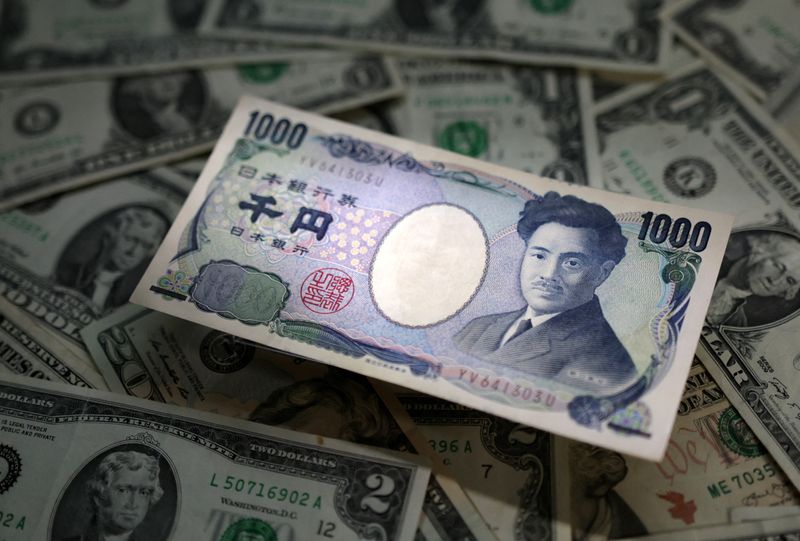
By Rae Wee
SINGAPORE (Reuters) -The yen swung between gains and losses on Wednesday after the Bank of Japan (BOJ) raised interest rates at the conclusion of its two-day monetary policy meeting and unveiled a detailed plan to taper its huge bond-buying programme.
The yen rallied as much as 0.8% to a more than three-month high of 151.58 per dollar immediately after the BOJ announcement but sharply reversed those gains in a matter of minutes as the outcome had been somewhat anticipated.
The Japanese currency was last marginally lower at 152.79 per dollar.
The BOJ said its board decided to raise the overnight call rate target to 0.25% from 0-0.1% in a 7-2 vote and decided on a quantitative tightening (QT) plan that would roughly halve monthly bond buying to 3 trillion yen ($19.63 billion), from the current 6 trillion yen, as of January-March 2026.
“Ahead of the meeting itself, the market had already been set up for a bit of a hawkish expectation,” said Alvin Tan, head of Asia FX strategy at RBC Capital Markets.
“You can say that the decision was hawkish overall in the sense that there was indeed a rate hike, but that was balanced, to some extent, by the less than expected quantitative tightening.”
Various news reports had earlier pointed to the possibility of a rate hike from the BOJ on Wednesday, setting the market up for such a move.
The yen looked set to end July with a gain of more than 5%, helped by Tokyo’s bouts of intervention and the unwinding of short-yen carry trades prior to the BOJ decision.
Wednesday was shaping up to be a busy day as investors will also get inflation figures from France and the wider euro zone bloc later in the day, alongside a policy decision from the U.S. Federal Reserve, which takes centre stage.
Spreading geopolitical violence also kept markets on edge.
Down Under, the Australian dollar slid to its weakest since May after core inflation surprised on the downside and greatly lessened the risk of another rate hike.
The Aussie was last 0.68% lower at $0.6494, having fallen more than 0.8% to a three-month low of $0.64825 after the Consumer Price Index (CPI) data. That left the currency heading for a monthly loss of more than 2%.
Markets abandoned bets of a further rate hike from the RBA and are now wagering on an easing as early as November. The RBA holds its policy meeting next week.
“If the RBA needed a smoking gun to tip the balance towards hikes next week, then this quarterly CPI print, while it certainly won’t please the RBA, isn’t sufficient to convince them to hike by 25bp next week,” said Chris Weston, head of research at Pepperstone.
Elsewhere in Asia, China’s July manufacturing activity contracted for a third month, an official factory survey showed on Wednesday, keeping alive expectations Beijing will need to do more to prop up its shaky economic recovery.
The yuan, however, was last 0.2% higher at 7.2374 per dollar.
BRACING FOR THE FED
The euro rose 0.08% to $1.0824 and was headed for a 1% gain in July, helped by an easing dollar.
Data on Tuesday showed the euro zone’s economy grew slightly more than expected in the three months to June, but the outlook for the remainder of the year was not quite so rosy.
Sterling advanced 0.06% to $1.28445 and was eyeing a monthly gain of 1.6%. The New Zealand dollar edged 0.02% higher to $0.5904, though was on track for a 3% drop for the month.
Traders were also keenly awaiting the Fed’s rate decision, likely the next main catalyst for broad currency moves after the BOJ. Markets expectations are for the U.S. central bank to lay the groundwork for a September rate cut.
Markets expect a September start to the Fed’s easing cycle, with about 68 basis points worth of cuts priced in for the rest of the year.
The dollar index dipped 0.04% to 104.39 and was set for a monthly loss of nearly 1.4%.
“We expect (the Fed) to open the door to a first interest rate cut in September. In our view, such a move today could send the wrong signal to markets and could spook investors,” said Barclays Private Bank chief market strategist Julien Lafargue.

“On the other hand, with markets already pricing in slightly more than 25bp worth of cuts in September, the Fed may find it hard to push back against these expectations.”
($1 = 152.7900 yen)
This post is originally published on INVESTING.



